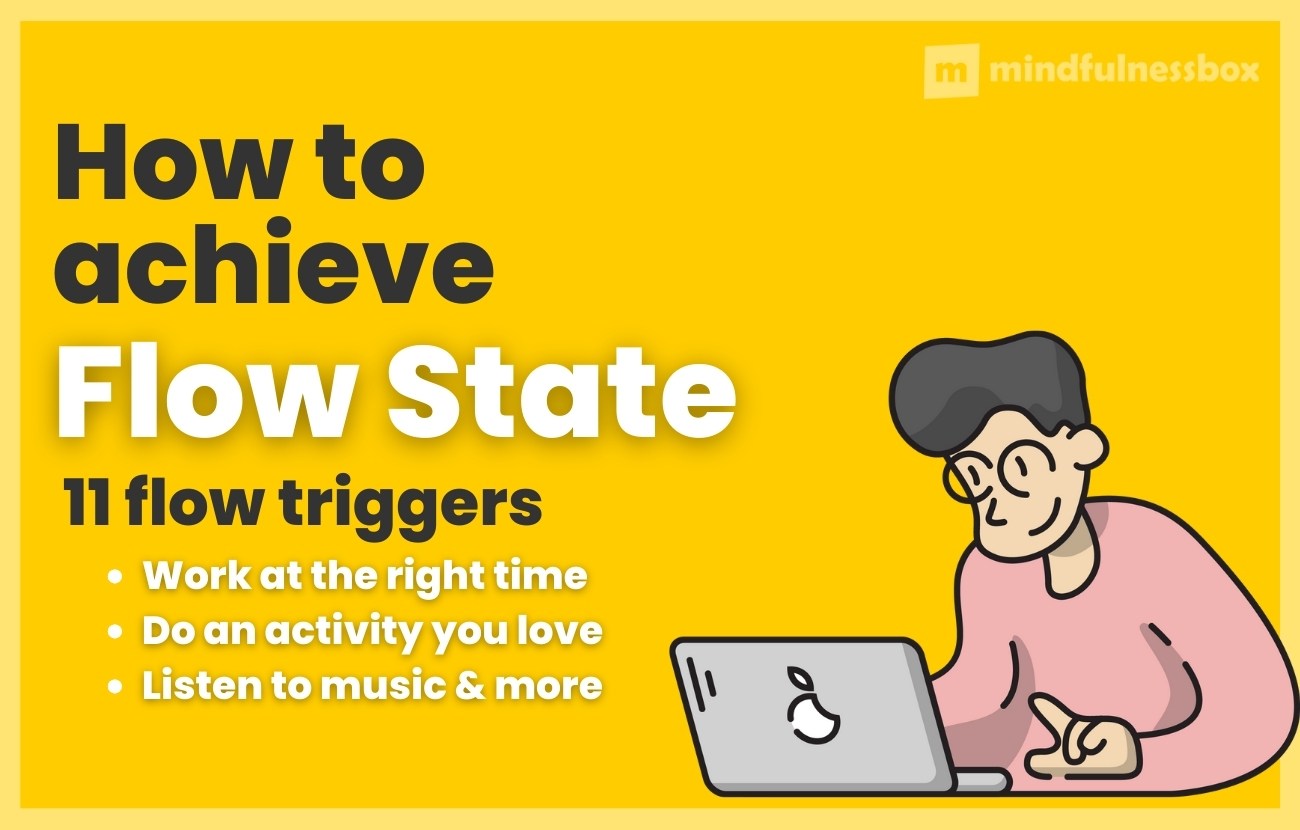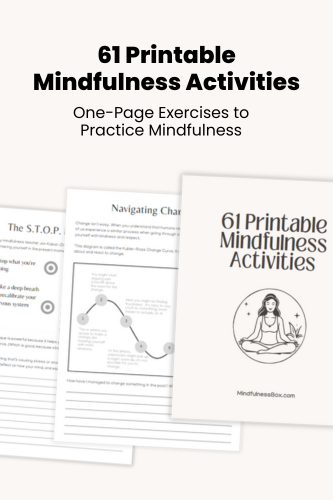There are a few things you can do to help induce a state of flow, starting with finding an activity that you enjoy (but that also challenges you). Then, practice it enough to become experienced at it. In this article, we’ll explore how to achieve a state of flow, and look at 11 flow state triggers than can help you get there faster.
We’ve all experienced the state of flow at some point in our lives.
It’s that feeling of complete focus and engagement with activities that you enjoy. The feeling of losing track of time while you become entirely immersed in what you’re doing.
Get dozens of one-page exercises to help practice mindfulness, meditation, gratitude, and self love. Perfect for printable handouts when teaching mindfulness to groups, students, or in the workplace.
To see examples, plus a full list of the 61 exercises included, click below.
This can be an activity as simple as taking a walk, or as complex as performing surgery. The key is that the person is so focused on the task at hand that everything else falls away. Time seems to stand still, and they are in complete control of their actions.
Why is the flow state so important, and how can we experience it more often?
Why is the flow state important?
Flow state has been shown to increase feelings of satisfaction and contentment, as well as improve productivity and performance.
Psychologist Mihály Csíkszentmihályi, known as the “father of flow,” described the concept like this:
“The best moments in our lives are not the passive, receptive, relaxing times . . . The best moments usually occur if a person’s body or mind is stretched to its limits in a voluntary effort to accomplish something difficult and worthwhile”
When you’re in a state of flow, you’re completely focused and engaged with the task at hand. You lose all sense of time, and you’re completely absorbed in what you’re doing.
This can be a great way to achieve better results on tasks that require creativity and problem solving skills. You may find that you’re able to come up with better solutions to problems, and that your creative juices start flowing more easily.
Thus, flow is important because understanding it may help us perform better, unlocking abilities we didn’t know we had.
It may also help us be happier: being in a flow state is usually described as an intrinsically positive experience, accompanied by feelings of accomplishment and contentment.
How to achieve a state of flow
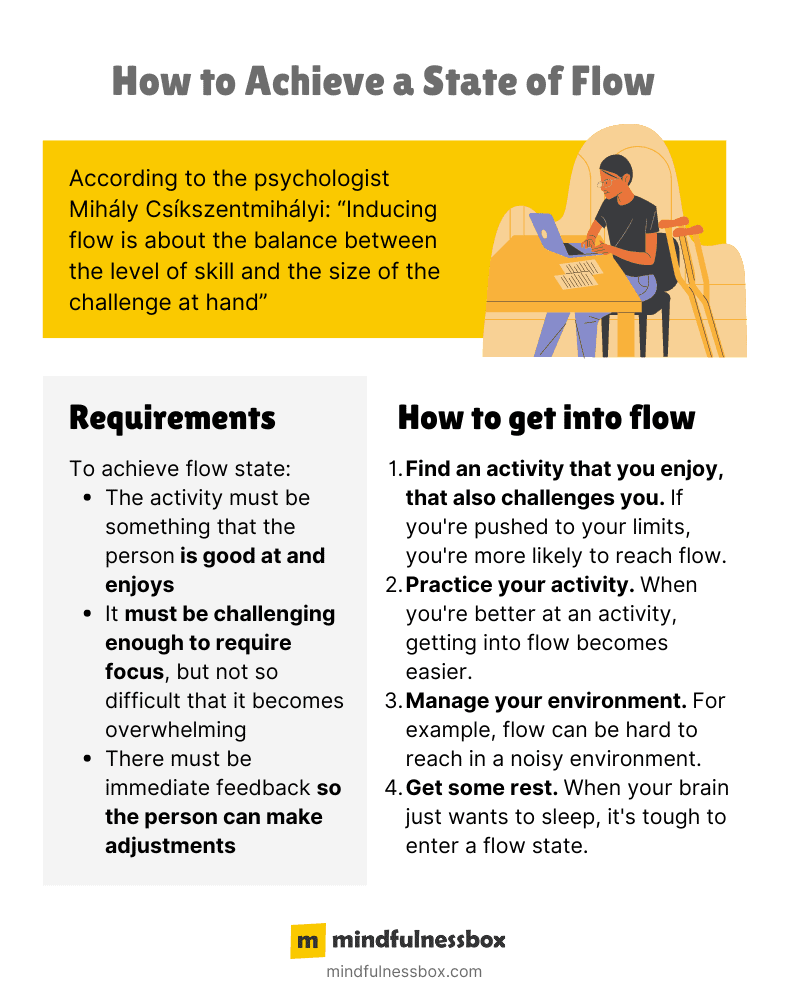
Wondering how to achieve flow state?
Here are the basic requires to get into a state of flow:
- The activity must be something that the person is good at and enjoys
- It must be challenging enough to require focus, but not so difficult that it becomes overwhelming
- There must be immediate feedback so the person can make adjustments.
Again, according to the psychologist Mihály Csíkszentmihályi:
“Inducing flow is about the balance between the level of skill and the size of the challenge at hand”
Keeping this in mind, there are a few things you can do to help induce a state of flow.
- Find an activity that you enjoy, that also challenges you. When you’re doing something that’s both enjoyable and also pushes you to your limits, you’re more likely to enter a state of flow
- Practice your activity. It’s difficult to reach a state of flow with an activity you’re new to. Practicing the activity so you get more experienced is a way to increase your chances of reaching a state of flow. Plus, if you followed step one, it’s an activity you enjoy – so that should be easy.
- Manage your environment. If you’re attempting to reach a state of flow with a solitary, creative activity, find out what environmental factors help, like a quiet office or soothing lighting and music. If you’re attempting to reach a state of flow with something active, whether public speaking or sports, you can manage what you wear, what you bring with you, and your own rituals and habits.
- Get some rest . When your brain just wants to sleep, it’s tough to enter a flow state. That’s the difference between performing an activity with abundant energy and simply grinding through it. If you’re grinding, your chances at flow are low.
11 Flow State Triggers for Focus
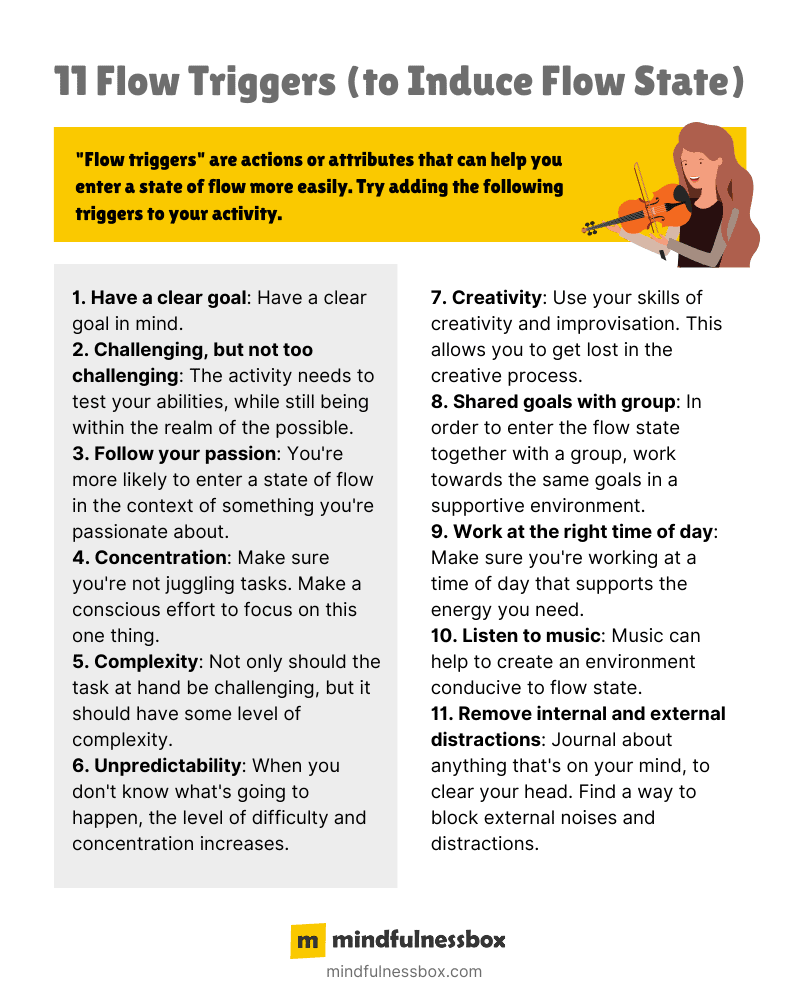
When you’re working to create an environment that’s likely to help you enter a state of flow, so-called “flow triggers” can help.
Here are some examples of flow state activities:
- Have a clear goal: You should have a clear goal in mind with the activity at hand.
- Challenging, but not too challenging: One of the key principles of flow is that the activity needs to be challenging, but not too challenging. It needs to test your abilities, while still being within the realm of the possible.
- Follow your passion: You’re more likely to enter a state of flow in the context of something you’re passionate about, that you can lose yourself in.
- Concentration: Make sure you’re not juggling tasks. Make a conscious effort to focus on this one thing.
- Complexity: Not only should the task at hand be challenging, but it should have some level of complexity.
- Unpredictability: When you don’t know what’s going to happen, the environment becomes more dynamic and the level of challenge increases.
- Creativity: Ideally, the task should make use of your skills of creativity and improvisation, allowing you to get lost in the creative process.
- Shared goals with group: In order to enter the flow state together with a group, you should be working towards the same goals in an environment where you’re supporting each other. Group flow triggers can help all of you get into the right mindset together.
- Work at the right time of day: All of us have certain times of day in which we’re more likely to do our best work. Make sure you’re working at the best time of day for you.
- Listen to music: Music can help to create an environment conducive to flow state, especially music without lyrics. Music can also reduce the chance of distractions from the environment.
- Remove internal and external distractions: Remove internal distractions by journaling about anything that’s on your mind. Remove external distractions by creating an environment that shields you from noises and demands on your time.
How long does it take to enter flow state?
How much time it takes to enter a flow state can depend on the person, situation and activity, as well as how experienced they are and what their environment is like.
It should take at least 10 or more minutes of completely focused attention to reach a flow state.
Often, it can be much longer. If you’re not completely focused on the task at hand, it will be difficult to achieve the flow state.
It’s challenging to reach a flow state immediately upon starting an activity, because the mind hasn’t had enough time to establish a rhythm of activity and become fully focused.
What does flow state feel like?
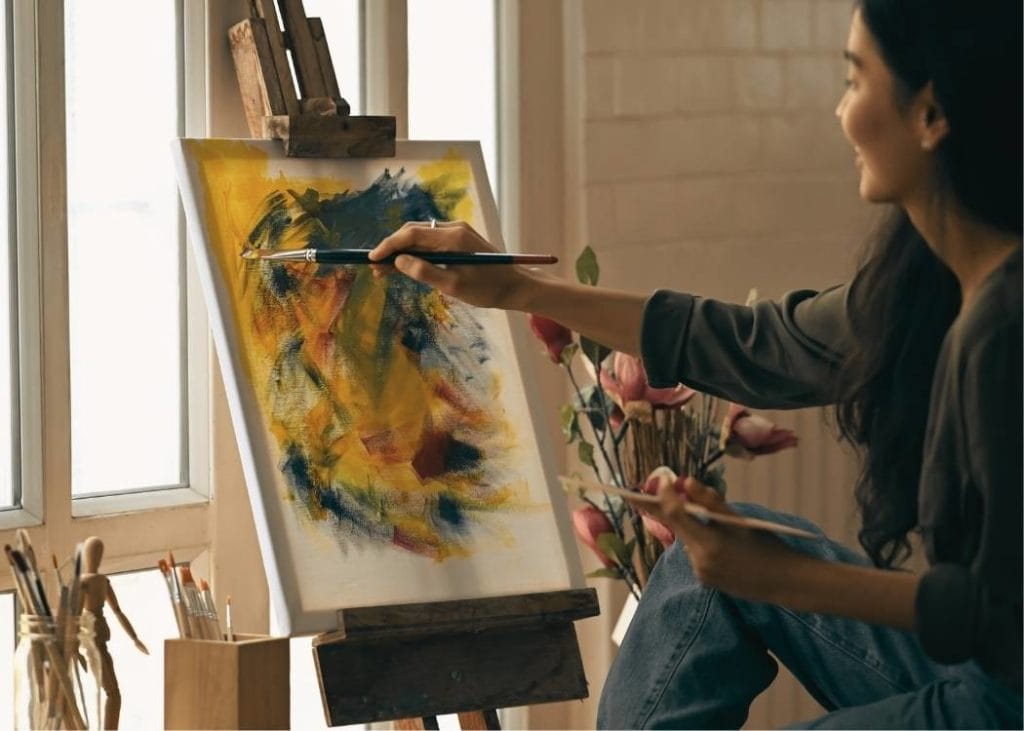
So, what does flow feel like?
When you’re in a state of flow, you’re completely focused and engaged with the task at hand. You’re not thinking about anything else. The outside world has disappeared, and you’re completely in the moment. Although the activity is challenging, and perhaps on the edge of your ability, you’re enjoying yourself and feel a sense of accomplishment along with contentment.
How do you know if you’re in a state of flow?
There are a few things to look for.
- First, you should be completely absorbed in what you’re doing.
- Second, the activity should be something that you’re good at, but that’s at a level high enough to challenge you.
- Finally, you should be getting a sensation of immediate feedback, such that you’re improving as you go along.
When you’re in a state of flow, you’re likely feeling content and enjoying yourself. While the activity feels challenging, there’s also a feeling of effortlessness, as if your skills and abilities are meeting the moment on their own. You may even find yourself smiling or laughing. The flow state is generally considered to be a positive and enjoyable experience.
Living in a state of flow
While the state of flow is temporary, we can increase the amount of time we’re able to be in that state.
Identifying activities we enjoy, practicing those activities to gain experience, engaging in the activities at a level that challenges us, and managing our environment can all help us more regularly reach the level of focus needed to enter a flow state.
When you’re living in a state of flow, you’re completely focused and engaged with the task at hand. You’re not thinking about anything else. The outside world has disappeared and you’re completely in the moment. Everything feels effortless and you’re enjoying yourself. You may even find yourself smiling or laughing, because you’re having so much fun.
Or to keep it short and sweet:
Find activities that are both enjoyable and challenging. Then do more of them.
Further reading
For more on mindfulness, focus, and productivity, check out these articles:
Frequently Asked Questions
Why do I get into the flow state when I stay up at night?
The late night and early morning usually allow for more solitude, more quiet, and fewer or no distractions.
These conditions can make it more favorable for your mind to focus fully on the activity at hand and enter a state of flow.
By contrast, during the daytime it often creates conscious effort to produce this same level of solitude, quiet and lack of distractions.
Can you force yourself into flow state?
People certainly try, but it’s difficult to “force” your mind to do something.
In fact, trying to force yourself into flow can even keep you from reaching flow—precisely because you’re too consumed with whether or not you’ve reached this state or not.
What you can do is to start observing what conditions tend to be more favorable for entering a state of flow, and reproduce those conditions. Rather than force yourself, you can nudge yourself.
For example, you might try working in the early morning when there are no noises or distractions or demands on your time. Then, you might listening to rhythmic instrumental music (like the kind found at Brain.fm) to help your brain enter a state of focus, and further drown out any distractions.

My mindfulness practice kicked off in 2016 with a ten-day silent retreat. Since then, I’ve read dozens of books about mindfulness and completed hundreds of hours of meditation. Thinking about what makes humans happy, calm, and peaceful is endlessly fascinating to me.

